 All Our Tours
All Our Tours
Written by: Vicky Nguyen
Updated date:02/08/2025
Hello, I’m Vicky! As a passionate travel enthusiast and tour planner at Asia Viva Travel, I’ve gathered extensive experience traveling across Vietnam and other captivating destinations in Southeast Asia. Now, I’m thrilled to share these adventures with you through my blog. From my journeys, I’ve gained a deep understanding of the unique cultures, hidden gems, and unforgettable experiences that this region has to offer. My goal is to bring you authentic and practical insights to help you design your own remarkable adventures. Join me, and let’s discover these extraordinary places together!
Contents
A country’s culture is not only reflected in its iconic landmarks and historical relics but also in its rich intangible heritage—melodies, dances, and unique traditions. In recent years, travelers eager to explore a new destination’s history and culture have moved beyond simply visiting famous sites; they now seek immersive experiences, with Laos food playing a key role in their journey. With Asia Viva Travel, visitors can delve deeper into Laos’ culinary heritage, uncovering flavors and traditions that make their trip truly unforgettable.
Lao cuisine, compared to other Asian dishes, may appear simpler at first glance, but it boasts a remarkably refined depth of flavor. This is largely due to the careful selection of ingredients—common yet fresh and high-quality components such as beef, pork, tomatoes, carrots, and papaya. While Lao dishes retain the classic balance of sour, spicy, salty, and sweet, they are particularly known for their bold and pronounced spiciness, which defines their unique taste.
Lao cuisine carries influences from neighboring countries like Thailand and Vietnam, yet it maintains its distinct identity through its use of fresh herbs, sticky rice, fermented ingredients, and spicy dipping sauces. Sticky rice (Khao Niew) is a staple in Lao meals, not just as an accompaniment but as an integral part of the dining experience, often eaten by hand and paired with various dishes. The extensive use of fresh herbs, such as mint, cilantro, and lemongrass, adds vibrancy to many Lao recipes, while fermented ingredients like Pa-dek (Pà đéc) fish sauce bring a deep, umami-rich complexity.
Lao food is known for its bold and spicy flavors, which are often enhanced by signature dipping sauces like Jeow Bong—a chili paste made with roasted chili, garlic, and buffalo skin, offering a smoky, fiery kick. A characteristic feature of Lao cuisine is its strong emphasis on sour and spicy elements, with the use of chili, lime, and tamarind to create a tangy heat that makes the dishes stand out.
Lao cuisine also incorporates a wide variety of fresh vegetables to balance the flavors and create healthy, vibrant dishes. Vegetables like tomatoes, cucumbers, and fresh herbs are essential in creating harmony in the meals, enhancing the flavors of meats and other ingredients.
Besides, Fermented ingredients, such as Fermented shrimp paste and Fermented fish past, are commonly used to add a deep, rich flavor to Lao dishes. These ingredients are vital for creating the umami backbone of many traditional recipes, adding a distinctiveness that sets Lao cuisine apart from other Southeast Asian culinary traditions.
Rice is the cornerstone of Lao cuisine, with various forms of rice being consumed regularly. Rice plays a central role in the dining experience, often shared communally. Sticky rice (Khao Niew) is perhaps the most iconic, often eaten by hand and paired with everything from grilled meats to spicy dips. Khao Lam (bamboo rice) and Khao Poon (rice noodles) are also popular variations.
Lao cuisine offers a truly authentic and immersive way to connect with the country’s culture. Its emphasis on fresh, locally sourced ingredients, bold flavors, and communal dining traditions makes every meal a unique experience. Whether you’re savoring spicy dips, indulging in fragrant noodle soups, or enjoying a plate of sticky rice with grilled meats, Lao food invites travellers to explore a lesser-known but deeply flavorful culinary world.
Larb (Laap) is a traditional and iconic dish in Lao cuisine, known for its unique blend of flavors. It is typically made from minced meat such as beef, pork, chicken, or fish, mixed with a fragrant combination of spices like lime juice, chili, galangal, lemongrass, basil, coriander, and rice bran. In Laos, Larb is often playfully referred to as “meat salad” because it is commonly served with rice or sticky rice—an essential food staple in many Asian cultures. Larb is considered a dish that brings luck and happiness, often enjoyed during festivals and celebrations. It is also a popular gift exchanged among Lao people as a symbol of goodwill and camaraderie.

Laap, the national dish of Laos, brings luck and flavor to every meal
In addition to regular rice, sticky rice is a common staple in many Asian cultures, as it is believed to keep people feeling full for a longer time. Dishes that pair well with sticky rice include Larb (meat salad), Tam Mak Houng (green papaya salad), Khao Piak Sen (rice vermicelli), Pha Phaen (fried noodles), and more. In Laos, Khao Niew (sticky rice) is traditionally cooked and served in a clay pot, symbolizing the solidarity and unity within families and the Lao community. While Khao Niew is not reserved solely for special occasions like the Tet holiday, it is a dish enjoyed daily by the Lao people. This reflects the deep respect the Lao have for rice, which is one of their most important crops.
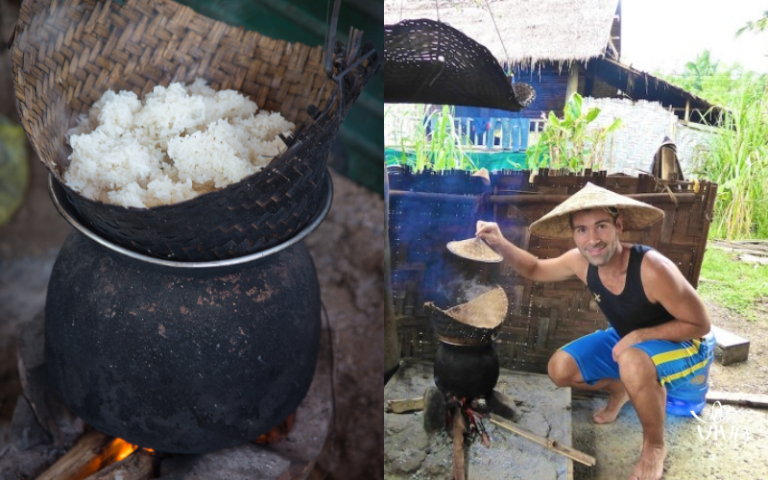
Khao Niew—an essential part of every Lao meal, eaten by hand for a true cultural experience
To truly experience Laotian culinary culture, you must try Tam Mak Houng (green papaya salad) at least once. Made from crunchy green papaya, tomatoes, chili, garlic, fish sauce, sugar, and lemon, this refreshing dish offers a perfect balance of flavors. The salad is traditionally prepared in a large mortar, where it is pounded with a pestle to allow the spices to blend evenly and the ingredients to soften for easier eating. While the preparation method may remind some of Thailand’s papaya salad, Lao Tam Mak Houng does not include peanuts, and it uses fermented fish sauce, which adds a distinctive depth of flavor. Typically, it is served with rice, making it a satisfying and flavorful meal.
A refreshing, spicy mix of papaya, chili, and lime—Lao’s take on the iconic green papaya salad
Khao Piak Sen, also known as Lao rice noodles, or affectionately referred to as “Lao pho” by many, is a beloved and iconic dish in the Land of a Million Elephants. This dish captivates diners with its rich, flavorful broth, stewed slowly from marrow bones, paired with deliciously chewy rice noodles and a variety of savory accompaniments. What sets Khao Piak Sen apart is its slightly thick soup, which carries a deep, sweet meaty flavor. It is traditionally served with fresh coriander, green onions, and crispy fried onions, all of which enhance the dish’s aroma and give it a delightful crunch. This comforting noodle soup is a perfect representation of Lao cuisine’s balance of flavors and textures, making it a must-try dish for anyone visiting Laos.
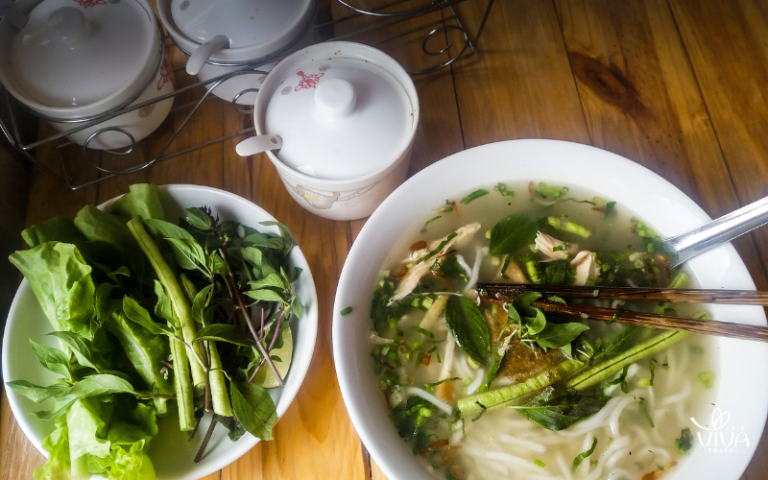
Khao Piak Sen—comforting rice noodles in a savory, rich broth
Another popular soup dish in Laos is Lam. This dish features a combination of eggplant, beans, lemongrass, wild mushrooms, basil, chili, herbs, and Mai Sakaan, a locally grown spicy plant that is a key flavor element in traditional Lao cuisine. Mai Sakaan is typically chewed for its strong, spicy taste, with the pulp discarded afterward. Lam can also be made with various meats, such as beef or chicken, and is typically served with sticky rice.
On special occasions, Lam may be prepared with buffalo meat, adding a richer depth to the dish. What makes Lam truly unique is its complexity, as it requires a long cooking time to ensure the meat becomes tender and fully absorbs the spices. The combination of the fragrant herbs and the distinct spicy kick from the Mai Sakaan root creates a truly unforgettable flavor experience, awakening the senses of anyone who tries it.
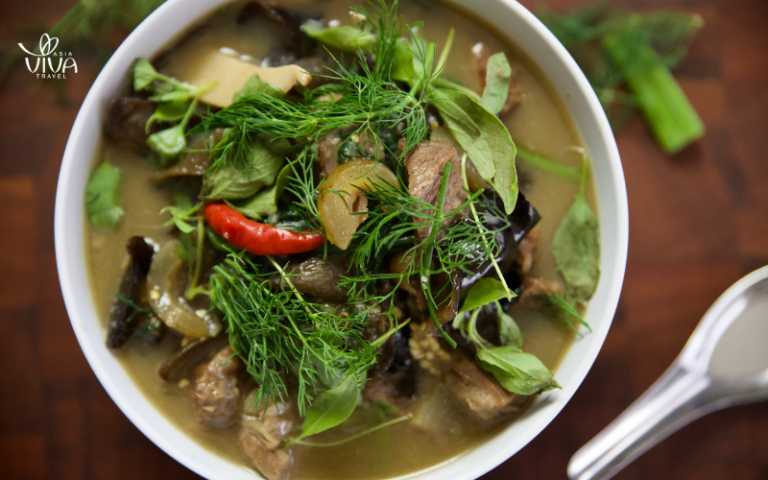
A hearty, spicy Or Lam stew made with buffalo meat, the perfect dish for cooler days
Tourists should not miss a chance to try these traditional Laos foods to truly understand the culture of Laos. The country’s famous dishes aren’t just food—they’re best Laos food, a reflection of its culture, history, and way of life. The bold spices, fresh herbs, and unique textures come together to create flavors that travellers won’t find anywhere else.
Thai and Lao cuisines share many similarities, but also have distinct differences that reflect each country’s unique culture. Both emphasize fresh ingredients, bold flavors, and the balance of sweet, sour, salty, and spicy.
Popular dishes such as grilled meats, curries, and noodle soups are commonly found in both cuisines, showcasing their shared culinary roots. Grilled meats, like som tam gai (grilled chicken), are enjoyed in both countries and are often paired with tangy salads and sticky rice.
Noodle soups, such as Khao Piak Sen in Laos and Khao Soi in Thailand, are comforting dishes made with chewy noodles and flavorful broths, offering a delicious taste of both cultures.
While many ingredients and preparation methods overlap, the key differences lie in the spices and flavor profiles. Lao cuisine often incorporates fermented fish sauce and the distinctive Mai Sakaan plant, while Thai food tends to feature more coconut milk and herbs like lemongrass and kaffir lime leaves.
Despite these differences, both cuisines share a deep appreciation for fresh, vibrant flavors that bring their dishes to life.
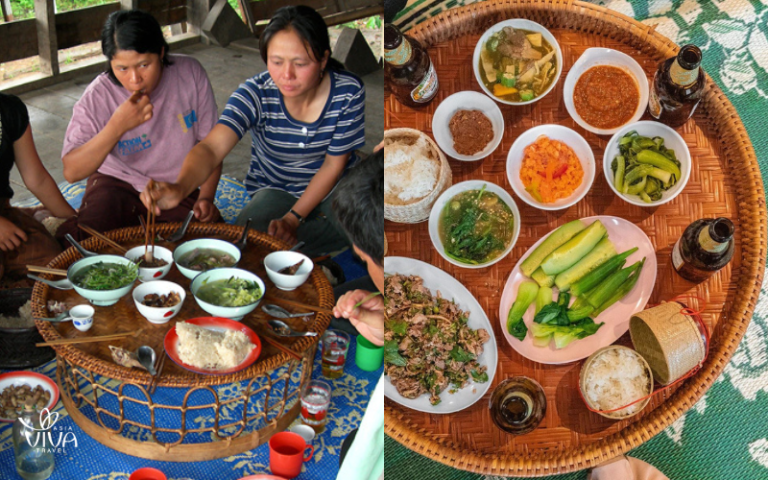
Lao meals are about more than food—they’re about community and tradition
For Muslim travelers visiting Laos, finding halal food options is easier than ever. While traditional Lao cuisine includes a variety of meats, there are many places in Laos that offer halal-friendly alternatives, ensuring that everyone can enjoy the authentic flavors of the country. Halal food can be found in major cities such as Vientiane, Luang Prabang, and Pakse, with numerous restaurants offering dishes prepared in accordance with halal practices.
Some of the best halal-friendly restaurants in Laos include:
– Sabaidee Restaurant (Vientiane) – Known for its tasty and authentic halal Lao dishes.
– Halal Restaurant (Luang Prabang) – Offers a mix of Lao and international halal options.
– The Muslim Restaurant (Pakse) – A local favorite with a range of halal meats and traditional Lao meals.
These restaurants ensure that Muslim visitors can enjoy Laos’ unique flavors without compromise, making it a welcoming destination for all.
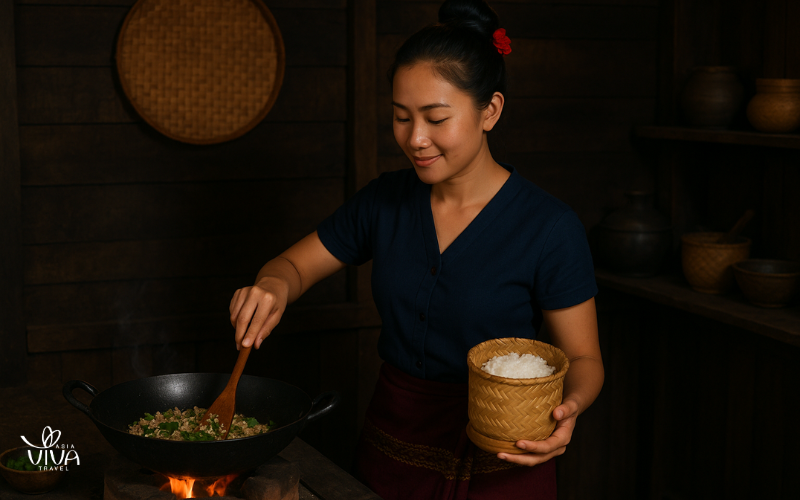
Easy Laos’ food recipes
For travellers who are passionate about Lao cuisine and eager to dive into the flavors of traditional Lao food, two must-try options are Laap and sticky rice. These dishes are not only staples of Lao cuisine but also incredibly simple to prepare. With easily accessible ingredients, even beginners can create these delicious dishes and experience the authentic taste of Laos in their own kitchen.
Laap (Larb) Recipe:
Ingredients:
– 500g minced meat (beef, pork, chicken, or fish)
– 1 small onion (sliced thin)
– 1-2 fresh chilies (chopped)
– 2-3 stalks lemongrass (chopped)
– 1 garlic clove (minced)
– Fresh mint, cilantro, and basil
– 1 tbsp fish sauce
– 2 tbsp lime juice
– 1 tbsp toasted rice powder
– 1 tbsp sugar (optional)
–Salt to taste
– Fresh vegetables (cucumber, lettuce, tomatoes) for serving
Instructions:
Sticky Rice (Khao Niew) Recipe:
Ingredients:
– 2 cups sticky rice
– Water
– Salt (optional)
Instructions:
Note: Some ingredients and spices may be difficult to find, but home chef can flexibly adjust to create dishes that best suit your taste.
Laos food is a delightful blend of bold flavors, fresh ingredients, and unique culinary traditions that are sure to leave a lasting impression. With its vibrant dishes, such as Laap, sticky rice, and Tam Mak Houng, Laos offers a taste experience that’s both exotic and comforting. The balance of sour, spicy, sweet, and salty flavors, combined with the use of local herbs and spices, makes Lao cuisine a must-try for any food enthusiast.
Whether you’re cooking these dishes at home or visiting Laos to experience them firsthand, exploring Lao food is an adventure that promises to be both satisfying and memorable. Don’t miss out on this culinary journey—try making these dishes at home or take a trip to Laos for an authentic and unforgettable food experience!
Ready to discover the flavors of Laos? Let Asia Viva Travel guide you on a culinary adventure with our tailored tours, offering authentic Lao experiences and unforgettable food journeys. Book your trip today and explore Laos through its delicious cuisine!

 19/11/2025
19/11/2025The Golden Triangle is one of the most legendary travel destinations in Southeast Asia, known for its history, stunning river landscapes, and multicultural influence

 08/10/2025
08/10/2025Discover Laos airports: 11 international & domestic hubs connecting travelers to Vientiane, Luang Prabang, Pakse, and nearby Southeast Asian countries.

 05/09/2025
05/09/2025Discover the Bolaven Plateau in southern Laos – explore stunning waterfalls, coffee plantations, local markets, and scenic loops with our complete travel guide

 23/08/2025
23/08/2025A true vagabond experience in the Pakbeng Laos river region, where the pace of life slows down on a slow boat trip, exploring peacefu villages and l landscapes